Types of Binary Options – A Straightforward Explanation
Lately we have seen more and more types of Binary Options being available for trading. Sometimes it can get confusing, especially for the new Binary Options trader. The binary options brokers usually do a pretty good job explaining the differences between them, unfortunately sometimes they lack simplicity in their explanations and most of the time they are concerned with telling us how much money we will make instead of how to make it. That’s the reason why we find it appropriate to explain the main types of Binary Options in a simple and easy to understand manner, and of course, using pictures. After all, we all know a picture is worth a thousand words. So let’s get the ball rolling and start with the most common types of binary options.
Common Types of Binary Options:
- Up/Down Options – The Expiry price should be higher or lower than the opening price
- ONE TOUCH/NO TOUCH Options – The Expiry price should touch a certain level before option expires
- Boundary Options – The Expiry price should be within a certain range before when options expires
- 60 Seconds Binary Options- Similar to Up/Down Options, but limited to 60 seconds expiry
- Pair Options – Price of X asset should be higher/lower than Y asset when option expires
- Ladder Options – Similar to Up/Down Options, with more expiry options. Consdired advanced method
Keep Reading to Learn more about the different types of binary options.
UP/DOWN Options
This is an easy one: I just need the expiry price to be higher or lower than the price where I opened the trade, depending on the type of trade I selected (Up or Down). It’s that simple. If I select UP (Call) and the price at expiry time is even one pip higher than the price where I opened, I win the entire payout. If I select DOWN (Put) and the price at expiry time is even one pip below the price where I opened the trade, I win the entire payout. Here is a picture to exemplify an UP trade:
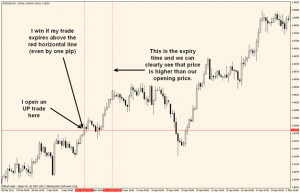
Price moved UP after I opened my trade and managed to stay higher at the expiry time: Ka-ching!
Binary Options “UP/DOWN” Conclusion in 50 Words
I am not going to discuss if this type of trade sucks because you must know when to use it and then there will be no “suck” factor. All types of binary option trades have a certain market condition when they work best and for the UP/DOWN option, the trending market is the best. Notice how in the picture above, we used the UP option in an uptrend. If you trade with the trend you are on the safe side and the probability that your trade will be successful is drastically increased. If the market is ranging, use another type of option.
UP/DOWN summary:
UP: win if price expires higher that the opening price
DOWN: win if price expires lower than the opening price
When to use:
in a trending market
ONE TOUCH/NO TOUCH Options
When using a ONE TOUCH option we express our opinion that the price will touch a certain level before time expires. We just need the price to touch the level once, until expiration and it doesn’t matter where the price goes once our price is touched because our trade has already won. For a NO TOUCH option, the opposite applies: we will receive the payout if the price doesn’t touch the predetermined level. Here comes the picture:

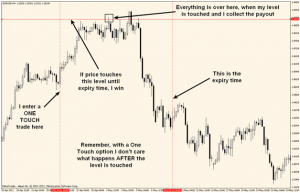
My target price (the red line) was touched before the expiry time and I will collect the reward. For a NO TOUCH trade, I need the price to stay away and never touch my predetermined level until expiry time. Although in a ONE TOUCH trade I don’t have to wait for the expiry time (if the target price is reached before, the trade is over for me, resulting in a win), in a NO TOUCH trade I must wait for the expiration time to see if the targeted price will be touched or not.
Binary Options “ONE TOUCH/NO TOUCH” Conclusion in 50 Words
This kind of options doesn’t suck when you are not sure about the sustainability of a certain level. For example, if you think a potential Double Top is forming, then you can use a ONE TOUCH option. When volatility is low you can use a NO TOUCH option, assuming that price will not reach the target price. However, do not use NO TOUCH options after prolonged periods of low volatility because a sudden and strong move can happen after periods like that. We all know the Asian session is pretty quiet so a NO TOUCH option will probably not suck then.
ONE TOUCH/NO TOUCH summary:
ONE TOUCH: win if price touches the target price until the expiry time.
NO TOUCH: win if price does not touch the target price until expiry time.
When to use:
Use a ONE TOUCH if you think a level will be reached but you are not sure that price will remain above/below that level.
Use a NO TOUCH in quiet market conditions (the Asian session is known to be slow moving). You can also use a NO TOUCH option for the short side in a strong uptrend or one for the long side in a downtrend. The idea behind this usage of the option is that price will not move against a clear trend so much that it will touch our price level.
IN/OUT or BOUNDARY or Range
When using an “IN” option, a trader expects the price to move between an upper and lower level (the boundary) without closing outside at expiry time. Let me give you an example: EUR/USD is currently trading at 1.2000. Let’s assume the upper boundary is set at 1.2050 and the lower boundary is set at 1.1950 and we choose “IN”. If at the expiry time, EUR/USD trades anywhere between 1.1950 and 1.2050, we receive the payout for that trade.
For an “OUT” trade, we need the price to close, of course, out of the boundary. Check out the picture below to see what a potential Boundary trade looks like. Notice that this picture exemplifies an “IN” trade (we need the price to be inside the boundary at the expiry time):
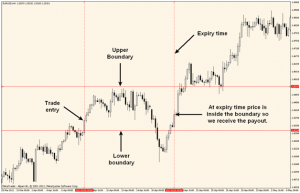
Even if the price gave us some sweaty palms when it exited the lower boundary just before our expiration time, it then returned inside it, making us win the much needed payout. The “OUT” trade requires the price to be outside the boundary for a win. You will find the IN/OUT type of option under different names, like Boundary, Range or Zone.
Binary Options “IN/OUT”/Boundary/Range Conclusion in 50 Words
The most important skill for a Binary Options, Forex, Commodity or any type of trader is identifying correctly the type of market he is trading at the moment. An “IN” option will suck in a fast, trending market, but at the same time, an “OUT” option will not suck during times like that. The opposite applies for a slow, ranging market.
IN/OUT summary:
“IN” win: at the expiration time, price is inside the boundary
“OUT” win: at the expiration time, price is outside the boundary
When to use:
Use an “IN” trade during ranging periods, with no clear trends or during quiet sessions.
Use an “OUT” trade during strong trends, after a retracement and during high volatility periods. In these times price is unlikely to remain confined inside a boundary.
60 seconds Binary Options
The last (but not least) type of trading Binary Options is the 60 Seconds option – pay attention guys, because this is where all the latest hype is. At the moment everybody is talking about 60 Seconds trading and in no way will I let it out of this article. You might wonder “What exactly is 60 Seconds trading?” and why all the hype? Those questions will be answered right now. Here it goes: 60 Seconds options are actually UP/DOWN options that expire in 60 Seconds (pretty straightforward, right?). If I select UP (Call) and at expiry time (60 Seconds later), the price is higher than what it was when I placed my trade, I win the trade and receive the payout. Vice versa is valid for DOWN (Put). Yup, that’s it, but let’s see what are the pro and cons of this type of Option. It is also recommended to check out 60 Seconds Binary Options Trading Strategy.
Why do “60 seconds” options suck and why they don’t suck?
This is a tricky question to answer because it really comes down to the mindset of the trader. Some traders like to be quickly in and out of the market and they need to see the result of their trades immediately, without waiting countless hours for the expiry time. From this perspective, 60 Seconds options are the next best thing after hot water and electricity and this is one of the reasons behind all the hype. I mean, I barely have time to place my trade and the outcome will be shown. And imagine how many trades you can place during trading hours if the result of the trade is known in one minute. These are the main reasons why trigger happy traders love this kind of Binary Option. But the same things that make them great can lead to a disadvantage: given that we just hold the trade for one minute, technical analysis (even for the most advanced traders) becomes very hard to apply. It’s almost impossible to determine what a price will do in the next 60 Seconds using Support and Resistance or Divergence or any technical analysis tool. Well, they are not the Holy Grail, but if you don’t like the stress that comes from a long expiration period and you need to constantly feel the thrill of being in the market, trading 60 Seconds options is certainly the way to go.
60 seconds summary:
They are UP/DOWN options that expire in 60 seconds so the same principles apply:
UP: win if price expires higher that the opening price
DOWN: win if price expires lower than the opening price
When to use:
this is pretty hard to answer, because personal risk appetite plays a big role and like I said, technical analysis is hard to apply for the next minute. However, my personal opinion is that a 60 seconds option should be used in a strong trend to increase our chances of success.
Pair Options
The name says it all… well, not quite, but it says a lot: in pair options, you pit one asset against the other and pick which one you think is going to perform better until the expiry time. Let’s use an example: you want to trade the pair Facebook vs. Google. If Facebook’s performance is better than Google’s during the period you’ve chosen for expiry and you have picked Facebook as the winner, then your option expires In The Money. If Google wins the race, then your option is Out of The Money.
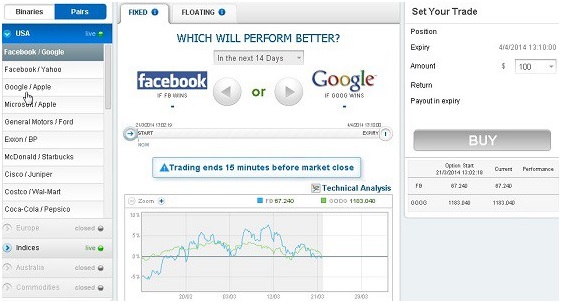
Even if the stock you’ve picked goes in an opposite direction than you originally thought, you can still win because all that matters is how it performs compared to the other. So in our example above: even if you thought Facebook will go up but it went down, you can still win if Google went down more.
Pair Options Conclusion
The direction of the asset is not very important with Pair Options and all that matters is to compare how the two components of the pair perform against each other. Because direction is not involved, sometimes it’s easier to trade Pairs than Up/Down, especially if you are familiar with certain stocks, indices or commodities involved in the pair.
When to use
WIN scenario: the asset you have chosen performs better than its counterpart does.
Ladder Options
Ladder Options are a relatively new addition to the types of binary options contracts available. I admit that trading Ladder is a bit more complicated, but nonetheless, it’s very simple once you get the gist. First of all, think about a Touch option: the trader needs to predict whether price will touch a predefined level (either above or below current price). Ok, Ladder means that you have additional levels, further away than your first one. Say current price is 1.1300; the first level of the Ladder is 1.1350 so if it’s hit, you win. See, so far it’s just like a Touch option. And here’s where the differences start to become visible: with Ladder, you have additional predefined levels, set at 1.1400, 1.1450, 1.1500, etc. (the broker defines these levels). If you pick a level that is further away from current price, the potential payout is significantly higher, but the probability of hitting that level is lower.
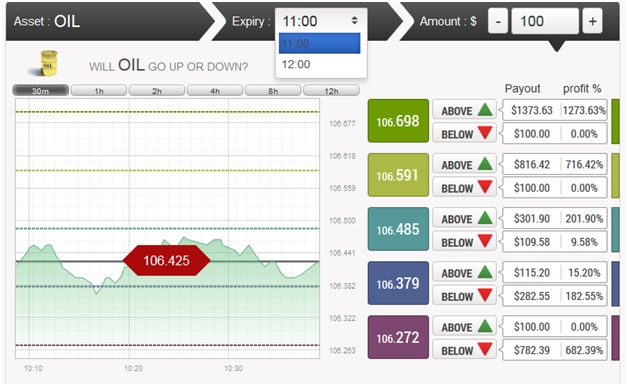
Ladder Options Conclusion
This type of option can be extremely profitable if a distant level is hit but you have to keep in mind that your brokerage will set the levels and often times they are difficult to reach (at least the top levels). Most assets move in one direction and then they retrace or pause before continuing and this retracement takes time; this often means that your option expires before the top levels are hit.
Summary
Win scenario: price hits the predefined level. If a more distant level is hit, the payout will be significantly larger.
When to use
This type of option works best in clean, strong trends or when a significant economic event takes place. Major economic releases (such as NFP, interest rates) often create strong movement and that’s when price can shoot through several levels.
____________________________________________________________________________________________
That’s it for our Binary Options types. Long read, I know, but success in the markets comes from hard work and I hope you feel more comfortable now with all their names and rules. Remember, No Binary Option Sucks if used when the time is right.